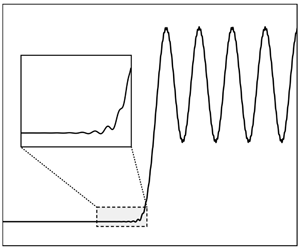Article contents
Gravity–capillary waves in reduced models for wave–structure interactions
Published online by Cambridge University Press: 13 March 2020
Abstract

This paper is concerned with steady-state subcritical gravity–capillary waves that are produced by potential flow past a wave-making body. Such flows are characterised by two non-dimensional parameters: the Froude number,  $F$, and the inverse Bond number,
$F$, and the inverse Bond number,  $T$. When the size of the wave-making body is formally small, there are two qualitatively different flow regimes and thus a single bifurcation curve in the
$T$. When the size of the wave-making body is formally small, there are two qualitatively different flow regimes and thus a single bifurcation curve in the  $(F,T)$ plane. If, however, the size of the obstruction is of order one, then, in the limit
$(F,T)$ plane. If, however, the size of the obstruction is of order one, then, in the limit  $F,T\rightarrow 0$, Trinh & Chapman (J. Fluid Mech., vol. 724, 2013, pp. 392–424) have shown that the bifurcation curve widens into a band, within which there are four new flow regimes. Here, we use results from exponential asymptotics to show how, in this low-speed limit, the water-wave equations can be asymptotically reduced to a single differential equation, which we solve numerically to confirm one of the new classes of waves. The issue of numerically solving the full set of gravity–capillary equations for potential flow is also discussed.
$F,T\rightarrow 0$, Trinh & Chapman (J. Fluid Mech., vol. 724, 2013, pp. 392–424) have shown that the bifurcation curve widens into a band, within which there are four new flow regimes. Here, we use results from exponential asymptotics to show how, in this low-speed limit, the water-wave equations can be asymptotically reduced to a single differential equation, which we solve numerically to confirm one of the new classes of waves. The issue of numerically solving the full set of gravity–capillary equations for potential flow is also discussed.
- Type
- JFM Papers
- Information
- Copyright
- © The Author(s), 2020. Published by Cambridge University Press
References
- 3
- Cited by


